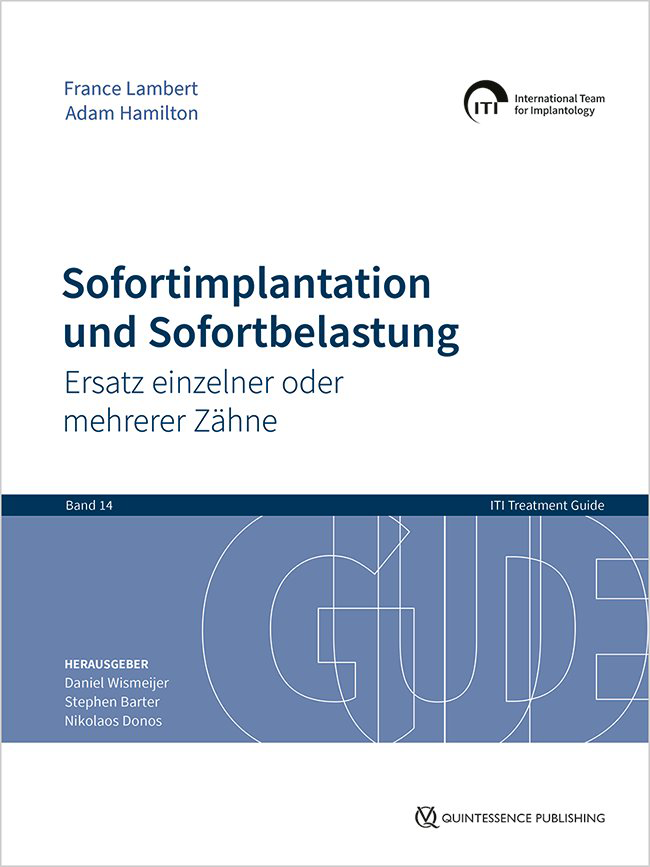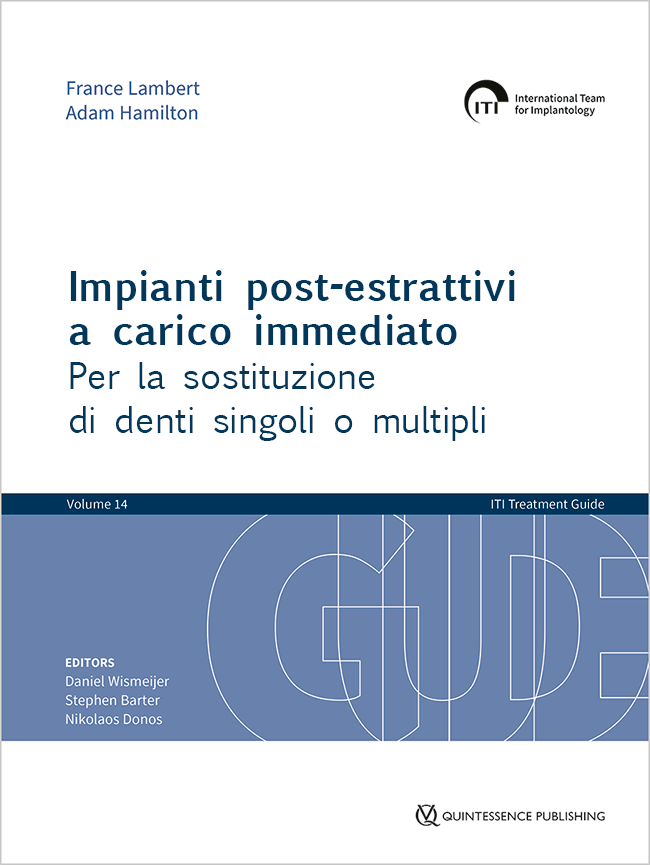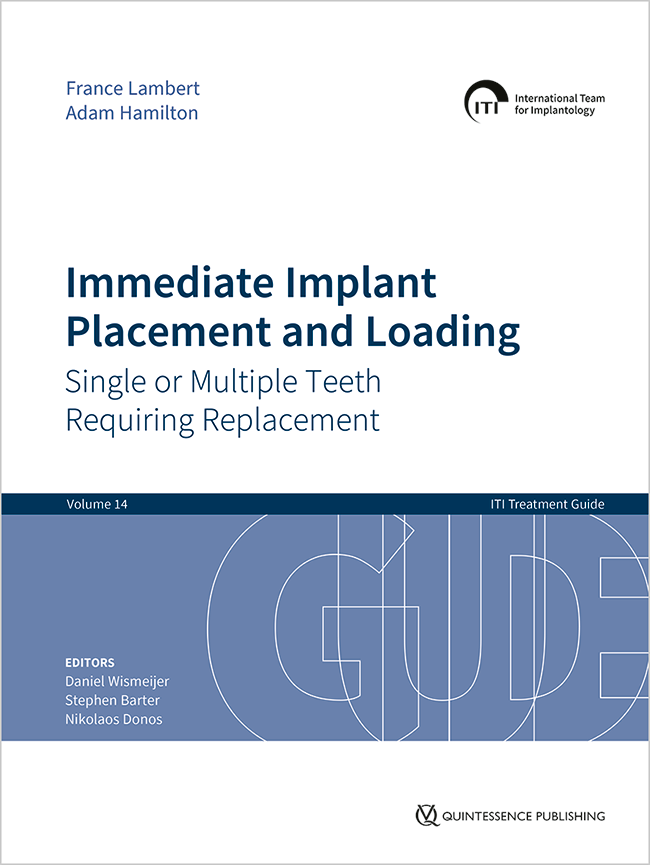International Journal of Periodontics & Restorative Dentistry, Pre-Print
DOI: 10.11607/prd.7168, PubMed-ID: 39270594September 6, 2024,Seiten: 1-18, Sprache: EnglischPeña-Cardelles, Juan Francisco / Markovic, Jovana / De Souza, Andrè / Hamilton, Adam / Lanis, Alejandro / Gallucci, German O.Introduction: The innervation of the hard and soft tissues of the maxillary anterior area depends on the nasopalatine nerve. Due to its anatomy and closeness to implants in the esthetic area, it is essential to fully comprehend its traits and possible effects while performing implant placement procedures. Objective: To assess the prevalence of neurosensorial alteration and the survival and success rate of dental implants in a relationship with the nasopalatine canal. Material and methods: A comprehensive search of the literature was conducted in the following databases: MEDLINE, Web of Science, and Scopus. The articles included had to be case series, studies conducted in patients undergoing dental implant procedures in the incisive canal region or undergone dental implant procedures with incisive canal deflation or neurovascular lateralization. A quantitative synthesis using a meta-analysis software program was performed. Fixed- or random-effect models were applied based on the heterogeneity among studies. Results: Four studies were included. Neurosensorial alterations were presented in three out of four articles included. The range of neurosensorial alterations varied from 30% to 60%. A weighted mean of 29 % ± 13 % of neurosensorial alterations was calculated from the meta-analysis meanwhile a mean of 100 % of implant survival and 100% of implant success were found. In the results, please clarify that "29%±13%" represents the weighted mean calculated from the metaanalysis. Conclusions: Implants in the nasopalatine area are associated with high rates of survival and success being a safe procedure, however, clinicians should be aware that neurosensorial alterations may be present when placing implants in this area.
International Journal of Periodontics & Restorative Dentistry, Pre-Print
DOI: 10.11607/prd.7127, PubMed-ID: 39058947Juli 26, 2024,Seiten: 1-21, Sprache: EnglischPedrinaci, Ignacio / Gallucci, German O. / Lanis, Alejandro / Friedland, Bernard / Pala, Kevser / Hamilton, AdamComputer-assisted implant planning allows for a comprehensive treatment plan by combining radiographic data provided by a Cone Beam Computed Tomography (CBCT) with surface optical scan (IOs) data that includes patient intraoral situation and the intended restorative planning. Integrating a tailored restorative design with the patient’s anatomical conditions through virtual implant planning allows for an ideal bio-restorative treatment planning to maximize biological, functional, and esthetic outcomes. This article discusses dataset registration techniques that combine radiographic CBCT data with restorative information as the main path to create a virtual patient. The described techniques include the use of removable radiographic templates with radiopaque markers, dual scan technique, and direct digital file registration of intra-oral scans using anatomical references. Depending on the individual clinical situation, different factors must be considered to appropriately select methods that achieve an optimal registration of diverse datasets. An inherent challenge lies in the presence of scattering artifacts in CBCT scans. Two approaches are proposed for these situations – the use of chairside-fabricated composite resin markers or adhesive spot-markers fabricated for the use with CBCT scans. Both techniques exhibit limitations that need to be taken into consideration. Further approaches should be developed for situations involving scattering in CBCT.
Schlagwörter: computer-assisted surgery, data superimposition, digital imaging processing, digital workflow, dual technique, scattering
International Journal of Periodontics & Restorative Dentistry, 4/2025
DOI: 10.11607/prd.7183, PubMed-ID: 38820273Seiten: 539-546, Sprache: EnglischLanis, Alejandro / Helmi, Alwaleed / Akhondi, Samuel / Hamilton, Adam / Friedland, BernardDigital implant planning—utilizing the convergence of digital surface scanners, CBCT scans, and advanced planning software—has transformed dental implantology. The merging of these datasets through triangulation of landmarks provides a detailed digital model of the dental arches, facilitating precise implant positioning in edentulous areas. A critical step in this digital workflow is the accurate merging of DICOM files with .STL/.PLY/.OBJ files, which underpins the design and fabrication of surgical templates for accurate implant placement. Errors in this phase can lead to implant mispositioning or damage to adjacent structures. Particularly in partial edentulism, the merging is based on the occlusal topography of the remaining teeth, but scattering in the CBCT data—caused by interactions of radiation with radiodense materials—can complicate this process or even render it impossible. The present article presents a technique utilizing radiopaque markers to overcome scattering effects, ensuring accurate dataset superimposition in the mandible.
Schlagwörter: CBCT, guided surgery, implants, scattering
International Journal of Periodontics & Restorative Dentistry, 6/2024
DOI: 10.11607/prd.6826, PubMed-ID: 38198437Seiten: 709-719, Sprache: EnglischPeña-Cardelles, Juan Francisco / Markovic, Jovana / Alanezi, Ahmad / Hamilton, Adam / Gallucci, German O. / Lanis, AlejandroThe interforaminal region is considered more favorable for implant placement than the posterior mandible in edentulous patients, mainly because the inferior alveolar nerve can interfere with implant placement in the severely resorbed posterior mandible. However, complications in the interforaminal region may occur due to the presence of the mandibular incisive nerve. This scoping review aims to describe the mandibular incisive nerve anatomy related to the potential interference in implant therapy. A comprehensive literature search was conducted in the following databases: MEDLINE (via PubMed), Web of Science, and Scopus. This scoping review was structured according to the Joanna Briggs Institute method. Thirteen studies were included in the review. All of the studies were observational cohort anatomical studies, carried out mainly by CBCT and on cadavers. A total of 1,471 patients/cadavers were studied. The mandibular incisive nerve was present in 87% to 100% of cases, with an average length of 9.97 mm and an average diameter of 1.97 mm. The mandibular incisive nerve may be damaged during drilling and implant placement, especially when using implant lengths > 12 mm. Damage to the mandibular incisive nerve due to implant placement could be present, but it is necessary to conduct more studies focusing on assessing mandibular incisive nerve damage to understand the clinical relevance of this nerve and its associated morbidities, such as neurosensorial alterations. Due to the different anatomical characteristics of this nerve, CBCT analysis is recommended for implant therapy in the anterior mandible to prevent the described complications.
Schlagwörter: dental implant, mandibular incisive canal, mandibular incisive nerve, neuropathy
The International Journal of Prosthodontics, 2/2024
DOI: 10.11607/ijp.8420, PubMed-ID: 37824117Seiten: 225-231, Sprache: EnglischKotina, Elli / Hamilton, Adam / Lee, Jason D / Lee, Sang J / Grieco, Peter C / Pedrinaci, Ignacio / Griseto, Neil T / Gallucci, German OTraditionally, metal-ceramics, metal-reinforced acrylics, and—more recently—full-contour or layered zirconia have been the materials of choice for definitive fixed implant-supported rehabilitations. Polymethyl methacrylate (PMMA) is commonly used in implant dentistry for the fabrication of implant-supported interim prostheses and as milled or 3D-printed prototypes. This article describes a novel protocol to prosthetically restore a completely edentulous patient following a digital workflow, with fixed, screw-retained, implant-supported prostheses fabricated from CAD/CAM milled PMMA, with no metal substructure. After a 2-year follow-up in terms of esthetics, phonetics, function, and biologic tissue response, the outcome remains functional and free of mechanical, biomechanical, or biologic complications. The aim of this article is to illustrate the feasibility of using milled PMMA as a viable definitive prosthetic material for the fixed implant rehabilitation of edentulous patients.
Schlagwörter: milled-PMMA, Implant-supported prostheses, long-term implant-retained restorations, CAD-CAM milled restoration
Implantologie, 1/2024
Seiten: 65-79, Sprache: DeutschHamilton, Adam / Obermaier, Barbara / Doliveux, Simon / Negreiros, William Matthew / Alnasser, Muhsen / Gallucci, German O.Eine klinische Fallserie In der vorliegenden Fallserie sollten Einflussfaktoren für die erfolgreiche Eingliederung CAD/CAM-gefertigter implantatgetragener Provisorien untersucht werden, die auf Grundlage einer virtuell geplanten Implantatposition vor der digital navigierten Implantatinsertion hergestellt werden. Die Daten wurden an Patienten gewonnen, bei denen für eine erforderliche Einzelzahn-Implantatversorgung eine digitale Volumentomografie (DVT) und Intraoralscans in eine Implantatplanungssoftware importiert wurden. Ein Synchronisationstool stellte die Verbindung zwischen der Implantatplanungs- und der CAD-Software her, in der eine digitale diagnostische Zahnaufstellung mit passenden Zahndimensionen und adäquater Weichgewebearchitektur erstellt wurde. Anschließend wurden die virtuelle Implantatplanung abgeschlossen und die geplante Implantatposition in die CAD-Software übertragen, wo eine Restauration konstruiert und zur Herstellung geschickt wurde. Nach der navigierten Implantatinsertion wurde das vorgefertigte Provisorium noch am Tag der Implantatsetzung oder, wenn eine verzögerte Belastung oder gedeckte Implantateinheilung indiziert war, nach der Heilungsphase eingesetzt. Die Auswertung erfolgte mittels deskriptiver Statistik und Z-Test für zwei Proportionen. Insgesamt 23 Patienten mit 28 Einzelimplantatstellen erfüllten die Einschlusskriterien und wurden in die Studie inkludiert. Neunzehn individuelle Gingivaformer und 10 provisorische Kronen für insgesamt 29 Restaurationen wurden digital konstruiert und hergestellt. Für die verglichenen Variablen fanden sich keine statistisch signifikanten Unterschiede. Das Fazit: Auf einer virtuell geplanten Implantatposition basierende, individuell vorgefertigte CAD/CAM-Implantatprovisorien lassen sich erfolgreich konstruieren, herstellen und eingliedern, wenn die Implantation navigiert erfolgt.
Originalpublikation: Hamilton et al. „Digitally Fabricated Provisional Implant Restorations Prior to Implant Placement: A Clinical Case Series.” (Int J Prosthodont 2022;35:94–108)1.
Schlagwörter: digitaler Workflow, CAD/CAM, Provisorium, Gingivaformer, Einzelimplantat, Implantatplanung, navigierte Implantation, DVT, Planungssoftware
The International Journal of Prosthodontics, 1/2023
DOI: 10.11607/ijp.7829, PubMed-ID: 36165883Seiten: 74-80, Sprache: EnglischDoliveux, Simon / Jamjoom, Faris Z / Albahri, Rami / Rousson, Dominique D / Hamilton, Adam / El Kholy, KarimThis case report describes a new digital workflow for computer-assisted implant surgery in an edentulous patient using transitional implants to support a fixed surgical template and interim prosthesis. The accuracy of the final implant position using the described protocol was evaluated and compared to the outcomes obtained using other types of surgical templates. This novel digital approach appears to enhance the accuracy of implant positioning for edentulous patients and seems to be comparable to a tooth-supported surgical template.
The International Journal of Oral & Maxillofacial Implants, 3/2022
DOI: 10.11607/jomi.9367Seiten: 525-532, Sprache: EnglischHamilton, Adam / Vazouras, Konstantinos / Friedland, Bernard / Gallucci, German O / De Souza, André
Purpose: This study aimed to assess the influence of implant diameter and taper on the proximity of virtually planned maxillary central incisor implants to the nasopalatine canal and adjacent anatomical structures.
Materials and methods: Virtual implant planning was performed in the maxillary central incisor position. The distance between the implant and the incisive canal (IC) and the thickness of the surrounding buccal and palatal bone walls were measured. Implants were categorized as having an exposed implant surface, thin bone, or moderate/thick bone. Measurements were repeated for regular-/narrow-diameter and parallel/tapered implants.
Results: A total of 60 patients were included, and 240 implants (60 of each type: 3.3-bone level [BL], 3.3-bone level tapered [BLT], 4.1-BL, and 4.1-BLT) were planned. The percentages of implants with between 0 and 0.5 mm of remaining bone in the coronal aspect of the IC were 31.6% for 4.1-BL/BLT and 6.6% for 3.3-BL/BLT (P < .001). The percentage of implants with IC exposure was 13.3% for 4.1-BL/BLT and 6.6% for 3.3-BL/BLT (P < .001). The frequency of sites that required bone augmentation at the coronal facial aspect (< 1 mm) was 52.6% and 33.9% for 4.1-BL/BLT and 3.3-BL/BLT, respectively. At the apical portion, the percentages of sites requiring bone augmentation at the facial aspect were 59.9%, 49.9%, 31.6%, and 23.3% for 4.1-BL, 3.3-BL, 4.1-BLT, and 3.3-BLT, respectively (P < .001).
Conclusion: The proximity of the nasopalatine canal is often < 0.5 mm from regular-diameter virtually planned implants at the most coronal aspect in the maxillary central incisor position. In these situations, the selection of narrowdiameter implants significantly lowers the incidence of implant exposure and the need for additional management of the nasopalatine canal and also results in greater residual buccal and lingual bone thicknesses surrounding the implant. As expected, tapered implants reduced the risk of implant exposure through the buccal cortex at the apical aspect.
Schlagwörter: diagnostic procedure, epidemiology, single implant, virtual reality
The International Journal of Prosthodontics, 1/2022
DOI: 10.11607/ijp.7623Seiten: 94-108, Sprache: EnglischHamilton, Adam / Obermaier, Barbara / Doliveux, Simon / Negreiros, William Matthew / Alnasser, Muhsen / Gallucci, German O
Purpose: To review the factors that affect the ability to deliver a CAD/CAM implant-supported provisional restoration designed from a virtually planned implant position prior to surgical placement with static computer-assisted implant surgery (sCAIS).
Materials and methods: Data were collected on patients treated with single-tooth implant treatment in which CBCT was combined with intraoral scans and imported into a virtual implant planning software. A synchronization tool established the connection between the planning software and the CAD software, where a digital diagnostic tooth arrangement was performed to create the ideal tooth dimensions and mucosal architecture. The virtual implant planning was finalized, and the implant position was transferred to the CAD software, where a restoration was designed and fabricated. The sCAIS was performed, and the prefabricated custom restorations were delivered on the day of the surgery or following healing if delayed loading or submerged healing was required. Descriptive statistics and statistical comparison with two-proportion z test were performed.
Results: A total of 23 patients with 28 single-implant sites met the inclusion criteria and were included in the study. Nineteen customized healing abutments and 10 provisional crowns were designed and fabricated for a total of 29 restorations. Of the restorations, 23 were successfully delivered on the day of the surgical intervention. No statistical significance was found among the different variables compared.
Conclusion: Custom prefabricated CAD/CAM restorations based on a virtually planned implant position can be successfully designed, fabricated, and delivered when used in combination with sCAIS.
The International Journal of Oral & Maxillofacial Implants, 6/2020
Seiten: 1203-1208, Sprache: EnglischSun, Teresa Chanting / Negreiros, William Matthew / Jamjoom, Faris / Hamilton, Adam / Gallucci, German O / Rousson, DominiqueSinus floor elevation with the lateral window approach has proven to be an effective treatment modality for vertical bone augmentation in the posterior region of the maxilla. The simultaneous implant placement during the procedure can be achieved if enough remaining bone height is available to obtain implant primary stability. However, the proper identification of the maxillary sinus boundaries for the window demarcation along with membrane protection for simultaneous implant placement can be challenging. This clinical report demonstrates a novel technique for sinus floor augmentation using a 3D modified implant-osseous-membrane surgical template to assist in the lateral window demarcation, membrane stabilization and protection, and guided implant placement in a partially edentulous patient who was eligible for one-stage sinus floor elevation. The surgical procedure for the sinus demarcation is simplified, the membrane stabilization and protection are effective, and the guided implant placement provided a predictable surgical positioning of the implants.
Schlagwörter: CAD/CAM, guided implant surgery, guided sinus floor elevation, sinus floor elevation, 3D printing







